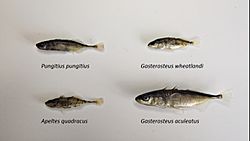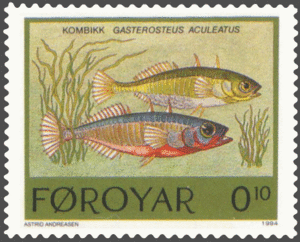Stickleback facts for kids
Quick facts for kids Sticklebacks |
|
|---|---|
 |
|
| Four marine species of stickleback from the Atlantic Ocean coast of North America | |
| Scientific classification | |
| Kingdom: | |
| Phylum: | |
| Class: | |
| Subclass: | |
| Infraclass: | |
| Order: | |
| Family: |
Gasterosteidae
|
| Genera | |
Sticklebacks are a group of small fish. They belong to a family called Gasterosteidae. These interesting fish are related to other unique sea creatures like pipefish and seahorses.
Contents
What Are Sticklebacks?
Sticklebacks are found in many places. Most live in the ocean, but some types live in fresh water. The freshwater sticklebacks became trapped in places like Europe, Asia, and North America after the Ice Age. Over time, they developed different features from their ocean relatives.
Sticklebacks are carnivores, which means they eat meat. They hunt and eat small animals like insects, tiny crustaceans, and the young of other fish.
One special thing about sticklebacks is their dorsal fin. This fin, on their back, has strong, separate spines. Another unusual fact is that sticklebacks do not have scales. Instead, some species have bony plates that act like armor.
How Big Do They Get?
The most well-known stickleback is the three-spined stickleback. It usually grows to about 3 inches long. The largest they get is about 4 inches. These fish are ready to have babies when they are about 2 inches long.
Most other stickleback species are about the same size or a bit smaller. However, there is one big exception: the fifteen-spined stickleback. This fish can grow much larger, reaching up to 8.7 inches (22 cm) in length!
Reproduction and Life Cycle
All stickleback species have similar and very interesting ways of mating. The male stickleback changes color, often developing a bright red chest. He then builds a nest using weeds, which he sticks together with a special glue from his kidneys.
After building the nest, the male tries to attract a female. When a female lays her eggs inside the nest, the male fertilizes them. He then guards the eggs very carefully until they hatch. Sometimes, he even continues to protect the tiny baby fish (called fry) after they are born.
Because the male spends so much effort building the nest and guarding the eggs, he can only mate with a limited number of females. This strong care for the young means that some male sticklebacks die after they have finished spawning.
Why Sticklebacks Are Important to Science
The three-spined stickleback is a very important fish for scientists. It lives in cool areas around the world, including Europe, North America, and Japan.
A famous scientist named Niko Tinbergen studied the behavior of this fish. His work helped create the field of ethology, which is the study of animal behavior. He used sticklebacks to understand how animals perform certain actions without being taught.
More recently, scientists have used sticklebacks to study how animals change over time, which is called evolution. They are like a "supermodel" for combining studies of genes, development, and how populations change in their environment.
In 2012, scientists mapped almost the entire genetic code of a freshwater stickleback. They also found many genetic differences between sticklebacks living in the ocean and those living in fresh water. These discoveries help us understand how animals adapt to different environments.
Genera of Sticklebacks
Scientists group sticklebacks into five main types, called genera:
See also
 In Spanish: Espinosos para niños
In Spanish: Espinosos para niños


